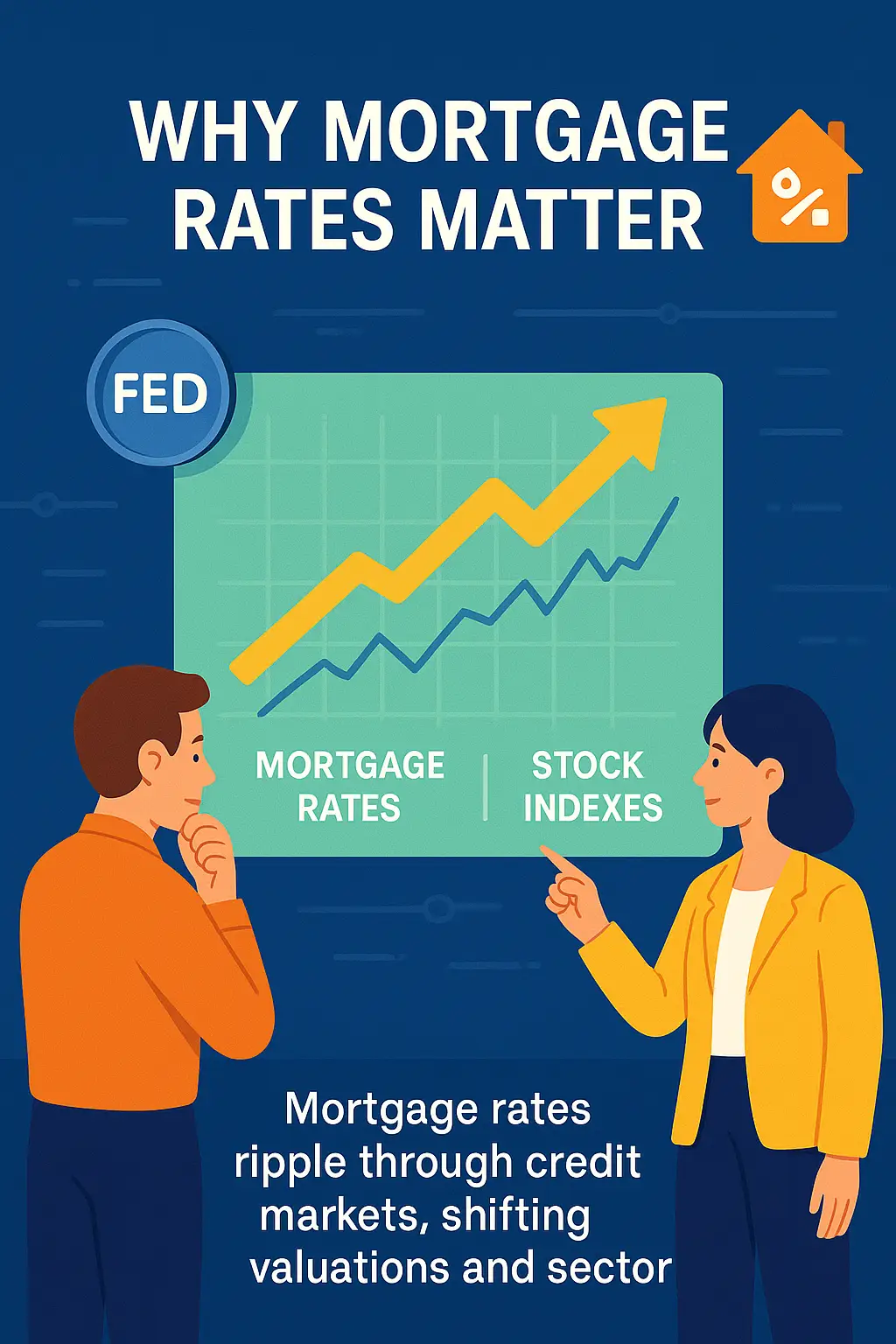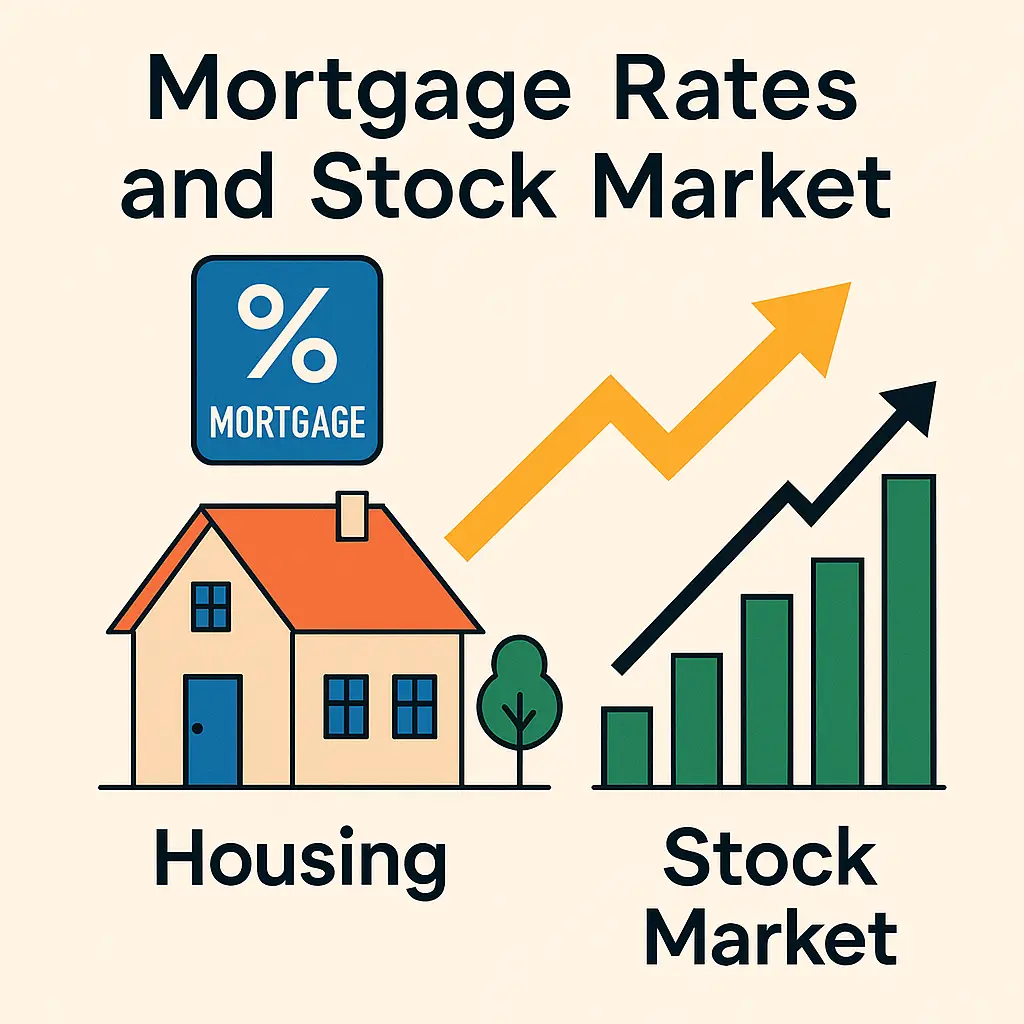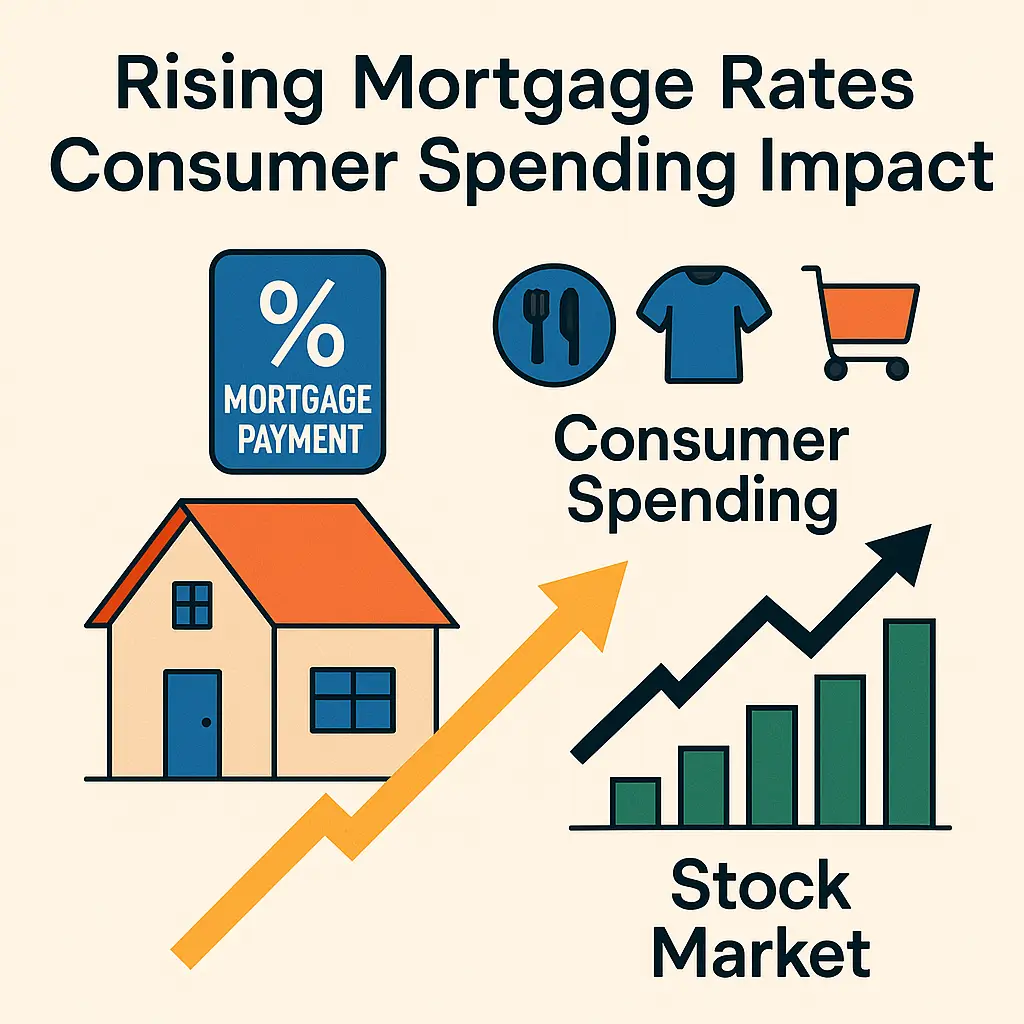
5 Smart Ways Mortgage Rates Impact Stocks Every Trader Should Know
Understanding the mortgage rates impact on stocks is essential for timing entries, managing risk, and spotting sector rotations. When the Fed adjusts policy, ripple effects flow through credit costs, housing demand, corporate earnings, and ultimately equity multiples—linking the mortgage rates and stock market in ways traders can exploit.
In this evergreen guide, we break down how rising mortgage rates shape liquidity, growth expectations, and interest rates stock performance across financials, homebuilders, REITs, and rate-sensitive tech. You’ll also see practical tactics for rising mortgage rates investing, plus how the housing market vs stock market dynamic evolves as the Fed interest rates effect works its way through the economy.
Quick Summary
- Why mortgage rates are a real-time signal for consumer demand and earnings multiples.
- Which sectors benefit or struggle as rates rise or fall.
- Actionable ways to align watchlists, entries, and risk with the rate cycle.
Why Mortgage Rates Matter for Stocks
Mortgage rates are not just about housing—they’re a proxy for the cost of credit across the economy. When the Fed shifts policy, banks adjust lending costs, and ripple effects extend into consumer spending, corporate earnings, and equity valuations. This direct link explains why traders must track the mortgage rates impact on stocks.
As borrowing costs rise, households face higher mortgage payments, reducing disposable income. That squeeze affects retail, travel, and discretionary spending, hitting earnings in consumer-driven sectors. Meanwhile, financials and certain cyclical industries may benefit, illustrating how the mortgage rates and stock market connection drives rotations that every trader should monitor.
To see how policymakers guide these rate moves, review the official Federal Reserve monetary policy page. For up-to-date mortgage data, CNBC’s mortgage coverage provides timely insights into rate changes and housing market shifts.

To build context, pair this knowledge with foundational guides like understanding the stock market, insights into capital gains taxes, and timing tactics such as when to buy shares. Together, these resources strengthen your edge in reading the rate-to-equity cycle.
Impact #1: Liquidity & Valuations
The first channel of the mortgage rates impact on stocks is valuation. When policy tightens and mortgage rates rise, financial conditions tighten, discount rates move higher, and price/earnings (P/E) and price/sales (P/S) multiples compress—especially for longer-duration assets like high-growth tech. This is why the mortgage rates and stock market link often shows up first in the multiples, not the earnings line.
How Higher Rates Pull Multiples Down
- Discount rate effect: A higher required return lowers present value of future cash flows → multiple compression.
- Risk premium repricing: As real yields rise, equity risk premia can widen, pressuring valuation bands.
- Liquidity drain: Tighter credit and pricier leverage reduce marginal demand for equities.
Who Feels It Most?
- Long-duration growth: cash flows far in the future (higher sensitivity).
- Speculative segments: low or negative earnings; dependent on cheap capital.
- Rate-sensitive defensives: certain REITs/utilities can de-rate when bond yields rise.
Who May Hold Up?
- Quality compounders: durable FCF, pricing power, balance-sheet strength.
- Selective financials: some benefit from net interest income dynamics.
- Shorter-duration cash flows: nearer-term earnings are less rate-sensitive.
Practically, traders watching interest rates stock performance should map sectors by “equity duration” and set valuation guardrails. When mortgage rates climb alongside Fed tightening, expect a de-rating first; earnings impacts often lag by a few quarters as financing costs and demand trends filter through.
Build your foundation with our primer on the stock market, review tax implications when rebalancing in capital gains taxes, and refine entries using golden timing: when to buy shares.
Action Step: Map Your Multiple Risk
Tag each ticker as long/medium/short duration and set fair-value multiple ranges. When rates rise quickly, reduce names trading above your top band; when rates stabilize or fall, scale into quality names returning to mid-band valuations.
Impact #2: Consumer Demand & Earnings
The second major channel of the mortgage rates impact on stocks is consumer spending power. Rising mortgage rates mean higher monthly payments, reducing disposable income for households. That cutback directly affects discretionary spending, which in turn pressures corporate revenues and earnings. This link between mortgage rates and stock market behavior often shows up in consumer-driven sectors before the broader indexes.

Sectors Under Pressure
- Retail & Discretionary: Consumers delay big-ticket purchases like cars or appliances.
- Travel & Leisure: Families trim vacation budgets under heavier mortgage obligations.
- Small-cap growth: Reliant on robust consumer demand; more exposed to slowdowns.
Potential Beneficiaries
- Discount retailers: Capture downshifted consumer demand.
- Financials: Some banks gain from higher net interest margins (though credit risk rises).
- Defensive staples: Food & essentials maintain steady demand even in tighter budgets.
Traders need to track earnings season carefully. Rising mortgage costs will appear in corporate commentary as “consumer headwinds.” By linking the rising mortgage rates investing theme with company guidance, you can anticipate which industries are likely to see margin compression or resilience.
For policy backdrop, review the Federal Reserve monetary policy updates and compare with CNBC’s mortgage rate coverage. Aligning Fed commentary with real-time mortgage shifts sharpens your outlook on interest rates stock performance.
Impact #3: Sector Rotations & Lead/Laggards
One of the smartest ways to understand the mortgage rates impact on stocks is to watch sector leadership. Rising or falling rates act like a rotation trigger, shifting capital from growth-heavy segments into cyclicals, defensives, or financials. Traders who grasp this mortgage rates and stock market connection can front-run leadership changes and improve risk-adjusted returns.
Likely Winners in Rising Rate Cycles
- Financials: Higher net interest margins support banks and insurers (though credit risk grows later).
- Energy & Materials: Often outperform as inflationary pressures and cyclical flows lift commodities.
- Discount retail: Consumers trade down, boosting budget-focused companies.
Likely Laggards in Rising Rate Cycles
- Homebuilders & REITs: Sensitive to mortgage demand, cap rates, and financing costs.
- Growth tech: Long-duration cash flows hit by higher discount rates.
- Consumer discretionary: Big-ticket items stall as budgets shrink under mortgage stress.
By contrast, in easing cycles or when the Fed signals cuts, these relationships often reverse: homebuilders, REITs, and high-beta growth regain leadership, while defensives lag. This dynamic shows why tracking the Fed interest rates effect and subsequent rotations is critical for timing exposures.
Action Step: Build a Rotation Playbook
Tag each sector ETF by rate-sensitivity and track performance before and after mortgage rate moves. Create “if-then” rules (e.g., if mortgage rates rise +20bps over 4 weeks, rotate 10% into financials, trim growth tech).
Impact #4: Housing Market vs Stock Market
Mortgage rates directly shape the housing cycle, which often moves inversely to equity multiples. When borrowing costs climb, housing affordability weakens, sales slow, and homebuilder profits compress. Investors rotate capital away from real estate, sometimes into equities. This push-pull explains why understanding the mortgage rates impact on stocks requires comparing the housing market vs stock market.

When Housing Weakens
- Home sales drop as affordability declines.
- Homebuilder stocks and REITs lag benchmarks.
- Capital often reallocates into broader equity markets.
When Housing Strengthens
- Lower mortgage rates revive affordability and sales.
- Housing-related equities outperform (builders, REITs, lenders).
- Consumer sentiment improves, fueling stock market optimism.
This cyclical relationship shows why tracking mortgage rates is critical for traders. A soft housing market can precede weaker consumer sentiment, while a housing rebound can spark risk-on flows in equities. Watch mortgage data closely—sources like CNBC Mortgages update trends that often spill into interest rates stock performance.
Impact #5: Trading Tactics in Rising Rates
Beyond theory, the mortgage rates impact on stocks creates tactical opportunities. Traders who adapt to the rising mortgage rates investing environment can capture alpha while others stay reactive. The key is balancing exposure across equity duration, sector leadership, and timing signals from Fed policy.
Practical Tactics
- Duration check: Tilt toward sectors with shorter cash flow duration (financials, staples) during rate hikes.
- Rotation watch: Track lead/lag signals across housing, REITs, and tech to spot turning points.
- Pair trades: Long financials vs short REITs during aggressive rate hikes; reverse when easing signals appear.
- Hedge smart: Use options or inverse ETFs to cushion volatility around Fed meetings.
FAQs: Mortgage Rates & Stocks
1. How do mortgage rates influence the overall stock market?
Higher mortgage rates increase borrowing costs, reduce consumer spending, and compress equity valuations—leading to slower stock market growth.
2. Which sectors benefit from rising mortgage rates?
Financials often benefit due to higher net interest margins, while defensives like staples and discount retailers may also gain as consumers trade down.
3. Are mortgage rates a leading or lagging indicator for stocks?
Mortgage rates are often a leading signal—tightening credit conditions usually precede weaker earnings and lower multiples in equities.
4. How can traders hedge against rising mortgage rates?
Use options strategies, rotate into financials, or deploy inverse ETFs to balance exposure in rate-sensitive growth sectors.
5. How does the housing market affect investor sentiment?
A strong housing market boosts consumer confidence and risk appetite, while a weak one often signals reduced equity flows and cautious positioning.
Conclusion: Smart Ways to Position
The mortgage rates impact on stocks spans multiple layers—liquidity, consumer earnings, sector rotations, housing cycles, and tactical trading. By recognizing these five channels, traders can anticipate how the mortgage rates and stock market connection plays out, rather than reacting after the fact.
Stay grounded in data, align with the Fed’s policy path, and use tactical frameworks like market basics, capital gains tax planning, and timing shares to strengthen your positioning.
Take Control of Your Strategy
Map your portfolio’s rate sensitivity, rotate as cycles shift, and trade with confidence. Mortgage rates are not background noise—they’re a front-row signal for every trader.